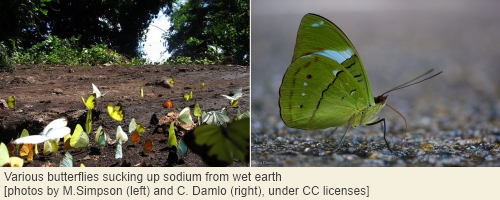Is there a reader who hasn’t scratched a head over the role of sodium in the human diet? The behaviour of Na in diet, health and ecology seems illogical. This is partly because sodium has an addictive aspect – and all addiction is paradoxical from an adaptive point of view.
A personal lifetime of self-experimentation with sodium has heightened these puzzles, and although Robin and the Honey Badger are no longer particularly tempted by salt (sodium chloride, NaCl), our interest in the biology of sodium remains as salutary as ever. Personal experience plus ongoing scientific investigation allow us to suggest some original hypotheses on this subject.
What is the biological paradox? Well, sodium is an essential nutrient for animals and particularly important for the ionic composition of blood. And plant material is far poorer in sodium than the bodies of the herbivorous animals that depend on the plants. Hence, the potential for Na-deficiency seems inherent in the natural order of things. However, sodium is also toxic enough that many animals and plants have special means of excreting it. The puzzle is that in the human species (and possibly other animals), our appetite for salt goes beyond any nutritional explanation. Indeed, our Na-hunger can seem to have a will of its own.

Sodium can be remarkably well-conserved by the body, casting doubt on the idea that humans would risk Na-deficiency without supplementing sodium in some way. The body is capable of efficiently recycling sodium internally and excreting it so slowly that deficiency is avoided even at minimal intakes. However, when the intake of sodium is increased in humans, something counterintuitive happens: the appetite for sodium proves self-perpetuating and self-promoting, even as we excrete the excess sodium. The resulting question may sting our hubris as biologists: what possible adaptive benefit might there be to passing sodium rapidly, rather than slowly, through the body? A salient difference between an urban junk-foodist and a hunter-gatherer is in the rates at which sodium enters and leaves the blood. When the rate of entry is excessive, there can be some banking up of sodium in the blood, causing illness. So, in today’s industrial world, it would seem that we eat sodium just to excrete it – if we’re fortunate enough not to ail en route.

Does anyone know of any other nutrient element for which there’s a system of positive rather than negative feedback in appetite? An induced demand for sodium seems to corrupt the sensory system of nutrition, and the mere habit of eating added sodium can lead to a strange predicament. Not only are superfluous intakes of sodium perpetuated by Na-appetite in what seems to be a vicious cycle, but food becomes potentially toxic with sodium simply to remain appetising to a salubrious taste. It seems that supplementation with sodium is both the solution to Na-demand in the short term and the exacerbator of Na-demand in the long term.
How is the paradox of nutrition compounded by the paradox of addiction?
Well, consider how odd it would seem if we compulsively supplemented sodium by hitting salt in pure form. Picture a closet Na-junkie with a little salt cellar in his pocket, secreting himself in a private corner to savour his fix of white crystals. In reality, there is less stigma in the liberal shaking of a salt cellar than in snorting a line of cocaine, although shaking it directly into the mouth would certainly get funny looks. But the real reason we don’t see such behaviour is that salt doesn’t taste good in pure form, even to the Na-addict, and eating it neat between meals would not stop a craving for that salty taste in food.

In reality, satisfying an Na-appetite seems, too often, to require the contamination of food. We say ‘contamination’ because we know that there is no safe limit for Na-excess, and some individuals start to suffer consequences at intakes well within the tolerance limits of other individuals. If addiction is defined as habitual self-harming, Na-appetite seems to be insidiously addictive. Sodium thus seems to link the biology of nutrition to the psychology of addiction. And, from a biological point of view, all addiction is paradoxical inasmuch as it contradicts evolutionary theory: how can behaviours evolve which are, by definition, maladaptive or even self-destructive?

With such a rich platter of theoretical confusion on offer at every meal, how can any biologist resist becoming something of a guinea pig? Here are some of our own self-experiments around sodium.
We grew up habituated to sodium: salt cellar on the dinner table, automatically shaken before even tasting food. On high school hiking trips, the remedy for muscular cramp was thought to be salt tablets. Did it work? Perhaps as a placebo. We came to question the salt habit and cared enough to live for decades, not years, on restricted intakes of salt. After only a few months of self-discipline, we got used to the taste of unsalted food, proving to ourselves that salt is only a habit and that, although ‘cold turkey’ can taste bland, this habit can be broken by a consistent exercise of will. The replacement of bad habit with good habit seemed to stick: we experienced no secret longing to return to any atavistic brine. Instead, we convinced ourselves that the mind is deluded when it complains ‘food this plain is a formula for salt-deficiency’.
Later, we experimented for a decade by simply collecting unpolluted sea water for the table. We used that moderately instead of refined salt, not as a condiment as much as a supplement to food. The idea was that sea water contains a balance of many elements and a modicum of trace elements. So, for example, we would add a tablespoon of sea water to the mashed potatoes. Harmless fun, but hardly great shakes for health or nutrition…
It’s known that human sweat contains little salt on the diet of a hunter-gatherer. But we’re curious whether even tears become fresh-tasting on a salt-sparing diet. Does any reader know the answer?

Going as far as to experiment with drinking our own urine showed us how the saltiness and acidity of the amber fluid varied with dietary choices. At one point it occurred to us that the body’s yellow surplus doesn’t necessarily taste any more toxic than today’s Na-contaminated processed foods – such as pretzels – might to a hunter-gatherer with an unadulterated diet. ‘Too much information’? Well, exploring the bio-edge begins in the human condition; self-knowledge is, in some ways, the frontier for biology.
We were always going to grow out of our salacious curiosity sooner or later. For the last decade we’ve moved beyond Na-mindedness and now we give sodium little mind in our diets. We have no particular craving to supplement sodium and no particular fear of added sodium either, because familiarity has bred no contempt but a balanced appreciation, free of compulsion. For us, sodium doesn’t belong on any Daemonic Table of the Elements. But our academic interest in the nutritional ecology of sodium has matured a little along the way, allowing us to offer a few suggestions in theoretical biology.
Could it be that the natural order is for sodium to function, in an approximate and fallible way, as an indicator for a more important nutrient: iodine? Na-toxicity may be a scourge in the era of industrial food, but iodine-deficiency has been a scourge throughout history. To this day, up to 30% of the world’s population remains at least subclinically deficient in iodine – despite the potentially easy fix of iodated salt. The human body can be deficient in iodine while completely sufficient in all other nutrients. And the stakes are high: a mother with only subclinical deficiency can give birth to a baby with permanent decephalisation.

Because of their chemical affinities, sodium and iodine tend to move in association through biological systems. Modern health authorities still find that supplementing the population with iodine can be done most efficiently via refined salt. This is because sodium and iodine go well together as elements, from the global geochemical scale right down to your bowl of soup. The sensory system, at least in humans, seems unable to detect iodine in its usual infinitesimals, measured in parts per million. So, the seemingly dysfunctional aspects of our attraction – and addiction – to sodium may have been compensated, at least pre-industrially, by the beneficial effects of a rather hit-and-miss natural system of supplementation-by-association of iodine.
One way to test this idea of salt-as-clue-to-iodine in other mammals would be to analyse the natural concentrations of micronutrients in the many geophagic sites (‘mineral licks’) used by large herbivores on several continents. Large herbivores eat earth for reasons that have never been fully explained, although in many cases such inorganic materials are naturally sodic. This idea pits the apparent dysfunctionality of sodium, one of the junkiest of nutrients, against the apparent megacatalysis of iodine, one of the highest-ranking of all nutrients.

So here’s a hypothetical way of distinguishing between a healthy appetite for salt and an addiction to salt. When salt is ‘licked’ in inorganic form, as at natural salt-licks, or micronutrient-rich organic material, such as kelp, negative feedback applies and the craving is satisfied. So an iodine-deficient human might, occasionally, crave salty material between meals but this would not exacerbate the appetite for salt. When, on the other hand, salt only tastes good in food, and food only tastes good with salt, it is a case of addiction and the fundamental reason may be that the underlying deficiency – that of micronutrients such as iodine – is not being satisfied.
Secondly, we may not fully understand the role of sodium until we understand the true function of the kidneys. The kidneys are far too dear, metabolically, to be explained away as primarily excretory. Excess sodium can alternatively be lost through the largest excretory organ in the human body, namely the skin. After all, the function of sweat as an evaporative coolant seems to gain nothing from dissolved salt. This raises two questions: why does the body pay so heavily to run the kidneys when the skin, rectum, and even mouth could be excreting many or most of the wastes including sodium? And what are the kidneys really doing when they routinely extract sodium and many other substances from the blood, keep them in the nephrons for a while, and then return most of them back into the blood? Urination starts to look like an ancillary function rather than a core function of the kidneys – suggesting that sodium may possibly play some undiscovered role in antioxidant chemistry.
But the energetic costs and real physiological benefits of kidneys are far too important to be done justice here. That may be a topic for another blog-post.
***
All text and images appearing in this blog are subject to copyright, except those images explicitly stated to be in the public domain. You are not free to use any photographs, for any purpose, without receiving written permission from the copyright holder.

